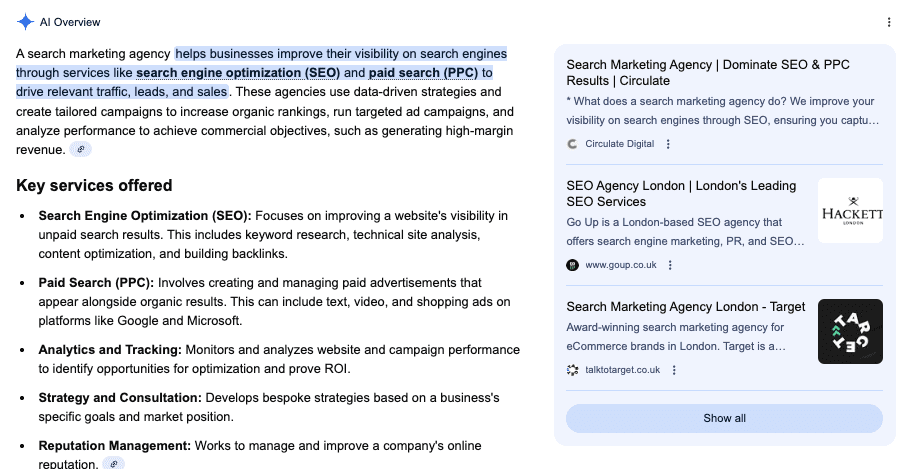
Recently, we’ve been appearing in more of Google’s AI Overviews, most notably for the term ‘search marketing agency’. That uplift’s come from tightening our technical foundations, sharpening our copy, and strengthening entity signals across the site. In short: we’ve made it easier for Google to understand who we are and why we’re credible.
Firstly, what are AI Overviews?
AI Overviews are Google’s generative summaries that appear above the traditional blue links for certain queries. They pull concise answers and then cite a handful of pages as sources. Those citations are the prize, you get visibility, authority, and a healthy slice of qualified clicks. They’re volatile, vary by location and user, and update often – so the only strategy that lasts is building real authority and making your page the easiest one to summarise.
The strategy in four pillars
- Answer first, fast
We rewrote our Search Marketing Agency page to answer the query in the first screenful: what a search marketing agency does, why it matters, who it’s for. Short, scannable bullets; no waffle. Think “explain like I’m busy”. - Entity-led SEO
We made it unmistakable to both users and machines that Circulate Digital is a search marketing agency offering SEO. That meant consistent naming, clean internal links, and structured data so Google could join the dots. - Proof of expertise (E-E-A-T)
Case studies, logos, testimonials, team bios, and clear contact details all live on (or within one click of) the page. We treated trust like a ranking factor – because in AIO land, it might as well be. - Squeaky-clean technicals
Fast load, stable layout, no indexation issues, and a clear architecture. If the bot can’t fetch and parse your page quickly, you’re out before you begin.
What we changed on the page (and why)
Reframed the opening to mirror “answer shapes”
AI Overviews love crisp definitions and benefit-led bullets. Our above-the-fold now covers:
- What we do: SEO under one performance-driven strategy.
- Why it helps: High-intent traffic, conversions, visibility, and expert guidance.
- Who it’s for: Brands that want measurable growth, not vanity metrics.
This isn’t keyword stuffing , it’s query intent mapping. We gave the model exactly what a helpful overview would say, in human language.
Tight information architecture
- Primary entity: “Search Marketing Agency” service page.
- Supporting entities: “SEO services” pages, each internally linked with descriptive anchors (not just using “click here”).
- Hub content: educational pieces, How to choose an agency, and Search marketing pricing factors. These create topical depth and give the model extra confidence we cover the subject end-to-end.
Credibility signals in plain sight
- Named experts on the page
- Client logos and short case study tiles with outcomes
- Reviews surfaced with a link to the source (not just star graphics)
- Real office details and an obvious route to talk to a human
Copy that’s easy to lift
We wrote with an eye on quotability, short sentences, active verbs, and benefits over features. If a line reads like something a human would paste into a summary, a model can lift it cleanly too.
The off-page work that moved the needle
- Consistent profiles: Clean, consistent information across LinkedIn, Clutch, business directories, and speaking bios. Same description, same services, same NAP where applicable. Consistency reduces ambiguity.
- Case studies worth citing: We created genuinely useful write-ups with process, constraints, outcomes, so third parties feel comfortable referencing them. Authority invites citations, citations invite Overviews.
Technical housekeeping (unsexy but essential)
- Core Web Vitals: Compressed hero media, deferred non-critical JS, trimmed render-blocking CSS, and lazy-loaded heavy components.
- Indexation: Pruned thin/duplicate pages, fixed canonicals, and kept sitemaps lean.
- Accessibility basics: Semantic headings, descriptive alt, keyboard-friendly components. Helpful for users, helpful for parsers.
How we knew we were on the right track
- Language parity: The bullets AIO surfaces for this query are strikingly similar to the benefits we lead with. That’s by design.
- Citations: Circulate Digital appears as a cited source in the Overview panel for UK users on certain devices and locations. That tells us Google trusts our page to support the summary.
- Behavioural signals: Longer time on page from AIO entrances and healthy enquiry rates. (We avoid publishing hard numbers here because results fluctuate by device, location and testing cohorts – but the direction is positive.)
Lessons you can steal
- Design “answer blocks” near the top. You’re writing for humans, but make it trivially easy to summarise.
- Declare your entity cleanly. Use consistent naming, obvious service relationships, and schema.
- Cluster your content. One strong service page and supporting explainers beats one bloated page every time.
- Show your work. Case studies, reviews, team bios, policies, and contact details build trust.
- Keep the site quick and tidy. Slow, jumpy pages don’t get picked.
- Expect volatility. Overviews change. Build authority that survives tests and toggles.
A simple checklist for earning AIO citations
- Clear, benefits-led intro that answers the query
- Descriptive internal links between Search Marketing and other relevant pages.
- Organisation, Service, FAQPage, BreadcrumbList schema validated
- Case studies and testimonials within one click
- Consistent brand descriptions across profiles.
- Fast LCP, low CLS, minimal render-blocking scripts
- Supporting blog guides that cover the topic from basics to buying
Finally…
We didn’t “game” AI Overviews. We organised information so well and backed it with evidence that Google felt confident using us to explain the category. That’s the job. If you’d like your brand to do the same, the playbook above is exactly how we approached it at Circulate Digital.
Want help building an AIO-ready service page and content cluster? Contact us today and let’s talk.
